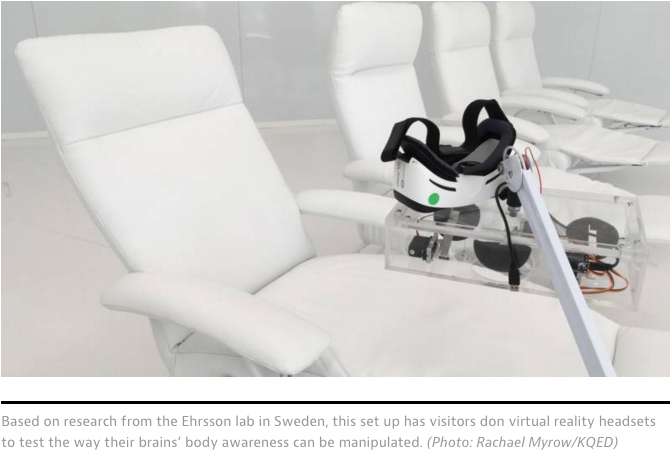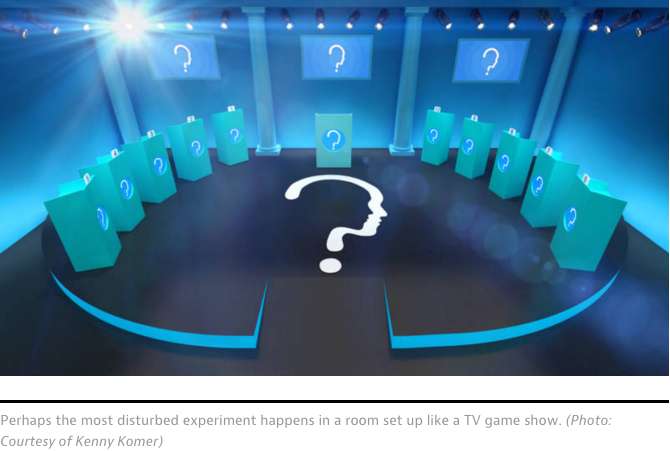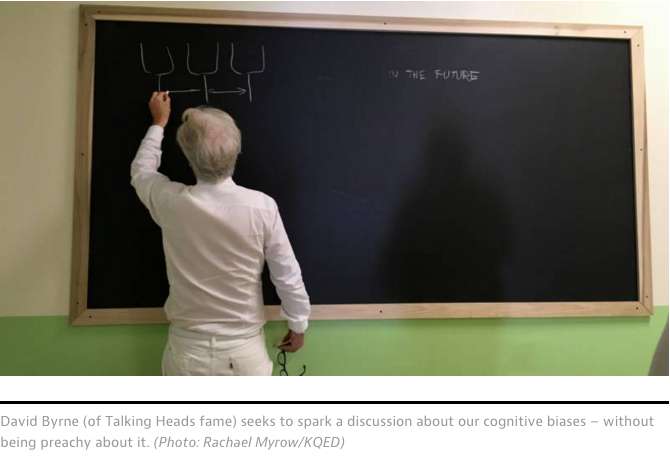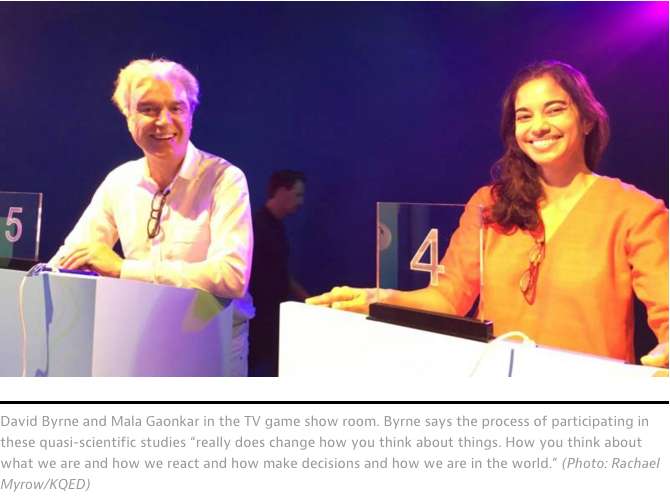David Byrne’s Theatrical Thought Experiment in Silicon Valley
Via KQED Arts

By Rachel Myrow
The first room is entirely white, including white floors so glossy you feel you should take your shoes off. A semicircle of white leather lounge chairs surrounds a stage screened off with a see-through white curtain. My first reaction? It looks like a nail salon run by Barbarella.
“That’s it. Yes, yes!” laughs David Byrne, my tour guide through this surreal space. Then he adds, “We don’t do nails. You get embodied in the body of a doll in this room.”
Byrne — yes, of Talking Heads fame and many other creative achievements — is walking me through his latest project, The Institute Presents: Neurosociety. It’s an immersive, participatory theater performance at Pace Art + Technology in Menlo Park, one of three Silicon Valley-based art spaces occupied by the New York-based Pace art gallery chain. The multi-room installation makes you, the visitor, a participant in a series of “scientific experiments” focused on how the human brain perceives what it senses, comes to conclusions, and then acts.
‘What you see might not actually be what’s out there’
In the room we’re standing in, the doll is topped by two cameras instead of a head. When you don a virtual reality headset, you can see what the doll sees. This has the effect of fooling your brain into adopting the doll’s perspective. The idea for this trick comes from Group Ehrsson, a neuroscience research firm based in Sweden, which did the very same thing in a lab much less sexy than this space.

Byrne is an avid fan of science. “I’d read about certain experiments that labs had done, and my immediate thought was ‘I want to do that,'” he says. “I want to be the subject. I want to see what that’s like.’”
Together with his friend, technology investor Mala Gaonkar, Byrne visited 35 research labs around the world to hear about the latest developments in cognitive neuroscience. Their conversations ranged from how your brain figures out where it is in space, to more complicated questions about how your sense of affinity with other human beings affects your moral judgement.
“What you see might not actually be what’s out there,” says Gaonkar. “And what you feel, including your deepest sense of identity, might not actually be what’s out there.”

Neural Science Professor Paul Glimcher leads the Kavli HUMAN Project at New York University, an interdisciplinary research group focused on decision-making in humans from a public policy perspective. He was among the scientists interviewed by Byrne and Gaonkar as they sought to educate themselves about cognitive neuroscience for their art project.
“David and Mala have designed a set of experiences that really lay bare the nature of our human experiences in areas ranging from perception to decision-making,” Glimcher says.
What if you were a drone pilot?
In another part of the installation, Byrne and Gaonkar have visitors watch a scene from the movie Eye in the Sky. In it, military commanders tell a drone pilot there are terrorists in a particular house, plotting a suicide bombing. He must blow the building up.
“You are cleared to engage, lieutenant,” says Colonel Katherine Powell, played by British actor Helen Mirren. But outside, there appears to be an innocent civilian, a woman preparing to sell bread. The drone pilot hesitates.
“Those men are about to disperse. Engage now!” Colonel Powell barks.
It’s a disturbing scene, and Byrne and Gaonkar want you to imagine yourself as that drone pilot, making that awful, split-second decision of life and death.
They also want to play with the nature of the moral dilemma.

“We start bringing it closer and closer and closer,” explains Byrne. Finally, the scene morphs so that we see a kid selling lemonade in front of a house on University Avenue in Palo Alto, instead of the bread seller in some far-off country. What fascinates Byrne is that people will change their response as to whether they’d blow up the building, and then retroactively search for justifications to explain why.
Had this been a real science experiment…
While the “experiments” at Pace draw on real research, this is theater, first and foremost. The situations don’t attach in lock step to specific studies Byrne and Gaonkar explored. Rather, the pair used their explorations to come up with something that evokes the same sense of wonder and surprise you might have as a study subject in an actual science lab.
At the end of their visit, visitors will get the results of these experiments, and the information will be shared with participating labs — though the labs have no plans to use the data. “This is really about sparking a discussion, as opposed to hardcore science,” Goankar says.

Byrne is convinced the installation will be transformative. “It really does change how you think about things, how you think about what we are and how we react and how make decisions and how we are in the world,” Byrne says. “It’s a bit pretentious to imagine that’s going to happen for everybody who goes through this, but it certainly happened to us.”